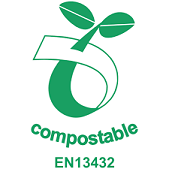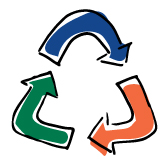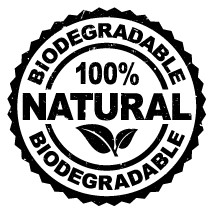The environmental impact of packaging
The environmental impact of packaging is closely related to the following factors: the material used, the purpose for which you use it, specific customer requirements and whether you can recycle or reuse it properly. In addition, the production of packaging requires raw materials and energy. Transporting and recycling packaging also costs energy. All this is harmful to the environment. Source: Milieu Centraal
Which materials are sustainable and which are not?
Are you curious about more sustainable alternatives for your flower and plant packaging? Read here which materials can be used.
Paper and cardboard
Paper and cardboard packaging made in the Netherlands, consist more than 90% waste paper. The rest consists new wood fibers that increasingly come from sustainable forests.
Whether paper is a more environmentally friendly packaging material than plastic depends on various factors. A kilo of paper causes fewer greenhouse gases than a kilo of plastic and the raw material (wood) is also renewable. However, for paper you also need production forests and they take up a lot of space.
By using old paper as a raw material for new paper, enough wood is saved every year in the Netherlands to build a two-meter-high fence from Amsterdam to Paris! 1 ton (1,000 kg) of paper weight saves 3.3 trees. Recycling in the Netherlands means that more than 7 million trees are not harvested and saved annually. Source: papierenkarton.nl Paper in the Netherlands is often collected door-to-door for recycling, although this varies from country to country.
Plastic
Plastic packaging has a bad environmental image. The environmental impact of disposing of agricultural and horticultural products, such as fruit and vegetables, is greater than the environmental impact of disposing of packaging. Consumers can reduce the environmental impact of plastic by submitting the packaging separately. It is up to us to properly inform in which waste bin that is. Source: www.keepbritaintidy.org
Koen Pack focuses on less environmentally harmful packaging. These less environmentally harmful packaging are made from sustainable and naturally degradable materials.
Do you want to know more about Koen Pack's environmental policy? We are happy to tell you more.
Do you choose paper or plastic?
Since paper is less strong than plastic, a paper bag requires thicker material than a plastic bag with the same weight. Moreover, the combination of paper and water is not optimal when packaging flowers and plants.
Both materials can be recycled well. Most plastics however have one major disadvantage: they do not decay in nature.
Would you like to know more about the different characteristics of packaging materials?
You can order our Sample Book.
Biodegradable
Organic fruit and vegetables, but also magazines are increasingly packaged in biobased plastic. Biobased plastic is made from plants such as corn, sugar cane or potatoes. The fibers of these plants are used as raw material. This is also called "biobased" or "biodegradable". They are renewable resources: you can plant them again and again. That is the advantage over ordinary plastic that is made from petroleum, a raw material that runs out.
A disadvantage of bioplastic is that (artificial) manure, pesticides and agricultural land are needed for production. Making fertilizer and pesticides costs energy and these products pollute the soil and water. There is less and less good agricultural land available worldwide that is needed for the production of food, wood, cotton, animal feed and bio fuels.
In which bin do you throw a biobased plastic packaging? Various logos have been developed to help you with this. Compostable biobased plastic can be recognized by the Seedling logo or OK compost logo. Although these packages are industrially compostable, they are not allowed in the kitchen and garden waste bin!
This seems contradictory, but the reason is that the bioplastic does not compost quickly enough. It is also not allowed to dispose it together with the plastic waste, because it has a different composition than ordinary plastic. Therefore, discard these packages with the residual waste. Do the same with plastic with no logo, but with the words compostable, biodegradable or biodegradable. Bioplastic is currently not recycled separately. On the other hand, the power plants are happy with it, because renewable material such as PLA gives a high energy value when it is burned.

The marks Seedling logo and OK Compost give the impression that consumers can dispose of products from these materials in the GFT waste. However, it is not the case because current composting installations have 2 weeks lead time, products with these logos require 12 weeks. The Koen Pack logo will soon make clear in which container it can be thrown away.
How does a composting machine work?
Composting is an easy way to return organic waste to the soil. It improves the condition of the soil and promotes plant growth. Composting requires food and carbon, such as wood pellets, moisture (from waste) and oxygen. Together with the microorganisms present, these elements ensure that heat is created and the composting process is put into operation.

Recycling
Koen Pack prefers recycling, since it’s always better to prevent plastic from ending up in the landfills or in nature. This is taken into account when developing our packaging. Most of our plastics are fully recyclable. The key point is to educate consumers to actually recycle all plastics and other materials. Wherever possible we show the recycle logo on our products. Would you like more information about this? Please contact us.
Quick links to other pages
HomepageStartpage Sustainability with Koen Pack
Sustainable packaging and the difference between organic and compostable
Koen Pack Waste policy and processing techniques
The environmental impact of packaging, do you opt for paper or plastic?
Request the Sample Book
Frequently Asked Questions about sustainability
What does Koen Pack do itself?
Knowledge sessions on location
Laws and regulations
Dictionary Sustainability


